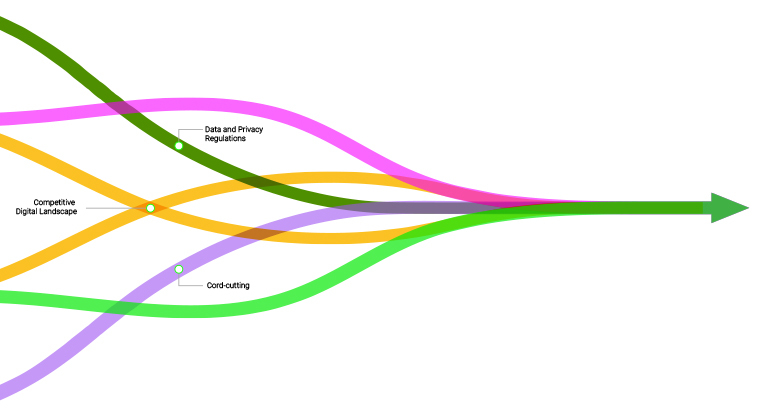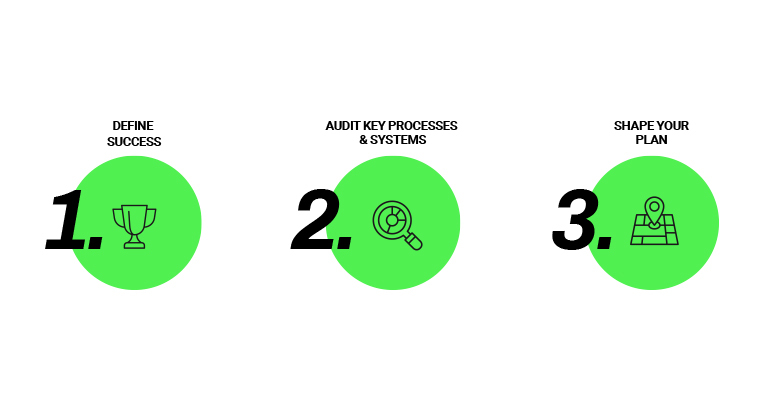Do You Have a Data Strategy to Engage Your Fanbase in Today’s Digital Landscape?
Disruptive technology trends are forcing the sports industry to rethink how we engage fans, who ultimately drive our business. At Next League, we are fortunate to work with many of the world’s leading sports organizations. One of the most common topics that we are discussing with our partners these days is the importance of a data-driven approach to fan engagement. A thoughtful data strategy enables a direct and personalized fan connection that helps sports organizations succeed amidst today’s challenging trends.
The Convergence of Disruptive Industry Trends

Competitive Digital Landscape
A golden digital growth era has ended. We now have more content competing for the attention of a slower growing digital audience. Throughout the past decade, sports organizations benefited from particularly favorable content supply and demand dynamics. However, nowadays, the major subscription video streaming platforms offer over 40,000 shows/movies[1] and individual content creators produce an abundance of video. On the other hand, we are now facing tempered internet[2], smart phone[3], and social media[4] adoption rates as most of the US population has already made those transitions.
Data and Privacy Regulations Continue to Force Marketers to Adapt
The tightening data and privacy landscape is leading the biggest technology platforms to protect consumers but it's also making it more difficult for sports organizations to understand, target, and engage their fans. Apple has implemented several changes aimed towards giving consumers better transparency and control of how their data is shared and used. Applications in the App Store now need to provide information about their data collection practices and must ask users for their permission to track them across apps and websites owned by other companies[5]. Google has also implemented similar policies for the Google Play store and intends to complete its third-party cookies deprecation for Chrome by the end of 2024[6].
The Cords Have Been Cut
The industry has been talking about cord cutting for almost a decade but now we have actually crossed that chasm. Studies have shown that more than 50% of households no longer have a telco, cable, or satellite TV provider and this number is projected to reach 75% by 2025[7]. The consumer shift is one of the main factors straining the traditional regional sports network model. This trend is also transforming the broader media model as the sports network giants, such as ESPN are doubling down on their digital platform efforts and partnering with FOX and Warner Bros. Discovery to launch the joint venture streaming service.
Data Unlocks Direct And Personalized Connection
Considering this confluence of impactful trends, how are sports organizations supposed to engage and grow their fanbases? The good news is that sports fans are as passionate as ever and a solid data strategy can help you overcome, and even take advantage of, this disruption.
The collection of basic contact information, such as email address and phone number, improves the ability to cut through the crowded landscape and have a conversation directly with fans. Properly collecting additional zero party-data and first-party data enables the development of robust user profiles, despite the biggest digital platforms’ data privacy changes. These profiles can be steadily enhanced to provide increasingly valuable insight into what matters to each individual fan (e.g. their attitudes, beliefs, behaviors, and motivations)[8]. Fans can explicitly provide favorite player or team information along with their actions, such as video consumption, emoji reactions, and purchase history, to yield powerful insights for sports organizations. This type of data collection starts to unlock some of the value that the big tech platforms have been capturing but it brings this capability in-house. Fan profiles are valuable across each step of a fan lifecycle, from early awareness to conversion and deep loyalty.
A data-driven relationship with fans can also help teams, leagues, and media companies overcome some of the current media transformation challenges. The direct relationship enables rights owners and holders to communicate directly with fans and transition them to the new distribution models/channels, such as direct-to-consumer subscription products. The richer fan profiles also enable the shaping of new sports media business models (e.g. individualized upselling). While we don’t believe that the direct-to-consumer model will match the regional sports rights fees in the short term, a strong data strategy will help sports organizations define new sustainable models.
Developing A Winning Approach For Your Business

While there is not a one-size-fits-all approach to building the next evolution of data-driven fan engagement, there are several best practices we routinely counsel our partners on:
- Define Success: Identify the key objectives for your fan engagement and broader business efforts (e.g. tickets sales, viewership, sponsor/partner value, and brand development) and prioritize them. This may seem like an obvious first step but these critical business objectives are often overlooked or rushed. Defining success enables you to identify what data the organization should collect to inform critical business decisions.
- Audit Key Processes and Systems: Regularly reviewing key processes and systems is key to success. Some areas we hone in on include:
- Privacy and Security: Assess your current guardrails (e.g. permission, storage and sharing) to not only meet regulatory requirements but to also grow trust with your fanbase.
- Tech: It is important to audit your tech stack to see, among other things, if you have the right tools to support your data stack from ingestion to processing, visualization, governance, and security. It is also critically important to ensure these tools are deployed and operate properly.
- Fan Value Exchange: Routinely examine the value you are providing fans in exchange for their data. In an effort to maximize this value exchange, you can consider whether you can provide additional content or launch a loyalty program?
- Shape A Plan Unique to Your Business: The nuances of your organization should shape your data-driven fan engagement plan. Establishing clear objectives and uncovering gaps are among the important ingredients for an effective plan. However, the plan is just a starting point. We like to work closely with our partners through execution and beyond. We are weary of the “set it and forget it” mentality as we know sound ongoing operations are critical to achieving success.
The sports industry is in the middle of a technological evolution. The digital landscape is maturing with increased competition and heightened regulation. These changes have meaningful implications for sports businesses, who are highly dependent on engaging fans. A thoughtful data-driven fan engagement strategy, along with proper technology deployment and management, is critical to helping sports organizations position themselves for success in this new landscape.
The above article is also available for PDF download here.
Acknowledgments
This piece is the first of a series of 2024 Next League publications addressing some of the most prevalent topics in sports technology. In the coming months we will continue the conversation on audience development, direct to consumer streaming, venue technology, artificial intelligence in sports, and more.
This research was led by Juan De Jesus, our Chief Strategy Officer, in collaboration with Tim Brady, Michael Clark, Bora Nikolic, David Nugent, Olivia Proctor, and Joanna Solowey.
